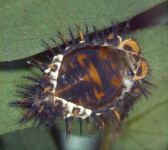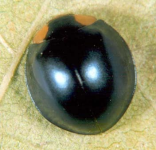Curinus coeruleus Mulsant |
||
| Order: Coleoptera Family: Coccinellidae | ||
| Common name / Category: Predator of Psyllid Heteropsylla cubana pest of subabul | ||
Curinus coeruleus (origin:Mexico) was introduced into India from Thailand in 1988 for biological suppression of subabul psyllid, Heteropsylla cubana. It has been successfully colonised in and around Bangalore. Its introduction has raised the hopes of many growers in protecting their plantation from complete destruction. |
||
| Production procedure | ||
Infested twigs of subabul with Heteropsylla cubana are obtained from the field. A bouquet of infested twigs is inserted in a plastic container (4 x 3 cm) provided with water and sealed with cotton wool. Each such bouquet is kept inside a 30 cm3 insect rearing cage with cloth sides, front sliding glass and zinc sheet bottom. Small strips (3 x 1 cm ) of card board cartons are cut and placed over the bouquet for egg laying. In each cage 25 pairs of newly emerged adults are released. Eggs laid in these strips are collected daily. |
||
The immature stages are reared in two phases. In first phase rearing, first two larval instars are reared in glass tubes (7 x 2.5 cms) @ 10 grubs/tube. Each tube is provided with infested twigs containing eggs and nymphs of H. cubana. Food is changed every alternate day. The grubs from the first phase rearing are transferred to second phase rearing on 11th day. In the second phase rearing, grubs are released over bouquets @ 25 grubs/bouquet. In each rearing cage (30 cm3) four bouquets are placed. |
||
The egg, 1st, 2nd, 3rd and 4th larval instars, prepupal and pupal stages lasted 7.5, 3.1, 3.0, 4.5, 7.3, 2.2 and 7.4 days, respectively. A generation is completed in about 35 days. |
||
The egg laying by the mated females starts 19 days after preoviposition period and occurs daily upto 67 days. Maximum eggs are produced between 23 and 41 days. Each female could produce a progeny of 155. |
||
It is possible to obtain about 90 adults per insect rearing cage after second phase rearing in about 20 days. By keeping 30 cages, which require about 2 man hrs/day for handling and providing food, 8,000 - 10,000 adults can be obtained in 60 days. |
||
|
||
|

